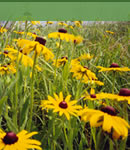HISTORY
What is a Conservation District?
No one is absolutely sure who
first came up with the idea of conservation districts. In 1934, Hugh Hammond
Bennett recommended that the district organizations could get landowners
and operators involved in conservation projects. At about the same time,
a report from the Department of the Interior also suggested such an organization.
Wherever the idea came from, it has been essential.
In 1936, the Department of Agriculture drafted a "Standard Act"
for organizing Soil Conservation Districts, and in 1937, President Roosevelt
sent a copy of the document to governors of all states with a letter recommending
that they act on it. The Illinois legislature passed the Illinois Soil
and Water Conservation Districts Act of July 9, 1937. Local people in
Christian County petitioned to the State to form a Conservation District,
and the District was formed according to State Law on April 15, 1947.
Districts cover urban areas with concerns about erosion from construction
sites as well as rural areas with concerns about erosion from crop, range
and forest lands. District Boards and staff are active in protecting water
quality and doing conservation education with the public. Districts consist
of unique partnerships between local, federal, and state entities that
have endured to meet the needs of landowners and operators.
The Function of the Conservation District
To take available technical, financial, and educational
resources, whatever their source, and focus or coordinate them so that
they meet the needs of the local land user.
ACTIVITIES
• The Christian County Soil and Water Conservation District
(SWCD) provides soils and land use information free of charge as requested
by local landowners. The District also distributes soil survey books for
Christian County when requested.
•The District has facilitated a project to digitize the Soil Survey for
Christian County and the Christian County Supervisor of Assessments. The
remainder of the project is being completed by Natural Resources Conservation
service Geographic Information Systems (GIS) analysts.
• The District worked with USDA-NRCS to implement the PL-566 project to
construct two large sediment retention basins at Lake Taylorville. Approximately
95% of the water flowing into Lake Taylorville is controlled by some type
of sediment retention structure. This improves water quality and prolongs
the life of the lake as a viable source of drinking water.
• The District offers a no-till equipment rental program for county farmers.
• The District provides cost-share to farmers through the State of Illinois,
Partners for Conservation Fund.
• The District provides Natural Resource Inventory Reports (NRI's) to
zoning offices in the county. These reports provide information regarding
land use changes when land is changed from Agricultural to Non-Agricultural.
• The District conducts a T by 2000 tillage survey every other spring
for the Illinois Department of Agriculture. The information is used to
help producers in Christian County establish better tillage and erosion
control practices.
• The District administered the 319 Grant from the Illinois EPA for the
City of Taylorville to build sediment basins around Lake Taylorville.
The District conducts yearly inspections of the basins with the City of
Taylorville Lake Department.
• The District installed a Lakeshore Stabilization Demonstration Project
near the marina at Lake Taylorville. This project was made possible with
2 grants that the District received. One was an Expansion Grant from Illinois
Department of Agriculture and the other was a "Clean Water, Clean Air
Grant" from Wal-Mart.
• The District, along with the Lower Sangamon River RC & D, provided a
grant to the Taylorville Fire Protection District for the cost of materials
to install a dry fire hydrant at Timber Lake Estates. This project was
coordinated with David Thomas in order for him to receive his Eagle Scout
status.
• The District, along with NRCS, assisted with a three acre prairie establishment
at Boyd Dappert Youth Reservation on Lake Taylorville.
EDUCATIONAL ACTIVITIES
• The District serves on the advisory committee of the Christian County
Soil Savers. The District staff helps to plan meetings and informational
tours for the group.
• The District continues to support the Lake Taylorville Resource Planning
Committee and its efforts.
• The District provides a newsletter four times a year to approximately
1600 producers.
• The District helped to establish the Christian County Agriculture Group.
In addition, the District participates in the Agriculture Expo at the
Christian County Fair and also helps sponsor the Annual Ag Appreciation
Dinner at the fair, which serves over 350 people to help promote agriculture
in the area.
• The District sponsors the Envirothon at Lake Springfield along with
Sangamon. Macoupin, and Montgomery counties. The winning team was from Christian County
and represented Christian County at the State competition at Allerton
Park near Monticello. The Taylorville High School team won the state competition
and participated in the National Envirothon in Flagstaff Arizona,
in May 2008. The Envirothon is an educational environmental competition
that focuses on soils, wildlife, aquatics, and forestry.
• The District helps sponsor the Ag Literacy position in Christian County.
CURRENT ACTIVITIES
• The district owns a Kinzie 3600 planter that may be rented to use for
no-till planting.
• The District received an IDNR Wildlife Habitat Stamp Fund Grant and
purchased a tree planter for the District. The tree planter is rented
to landowners and operators in Christian County. The tree planter provides
support for the CRP program when riparian buffers are required.
• The District, along with NRCS, has been working to implement several
CREP conservation plans. To date we have 47 State Contracts that will
cover the county. CREP is a program that utilizes Federal and State resources
to retire frequently flooded and environmentally sensitive cropland. The
major goal of CREP is to apply conservation practices that will reduce
sedimentation and nutrients in the Illinois River watershed, while creating
and enhancing habitat to increase fish and wildlife populations.
|





